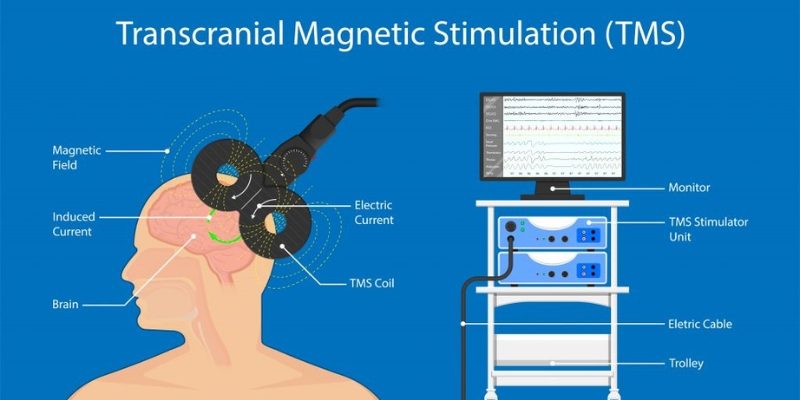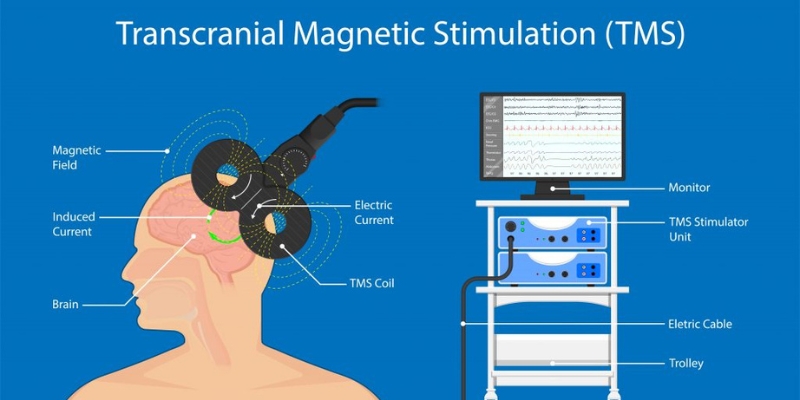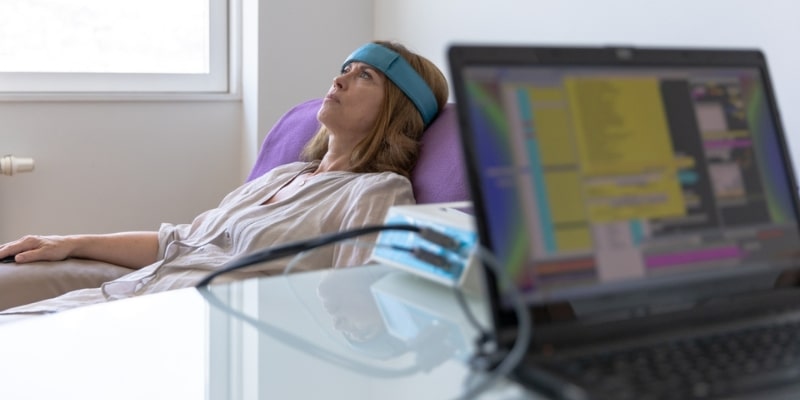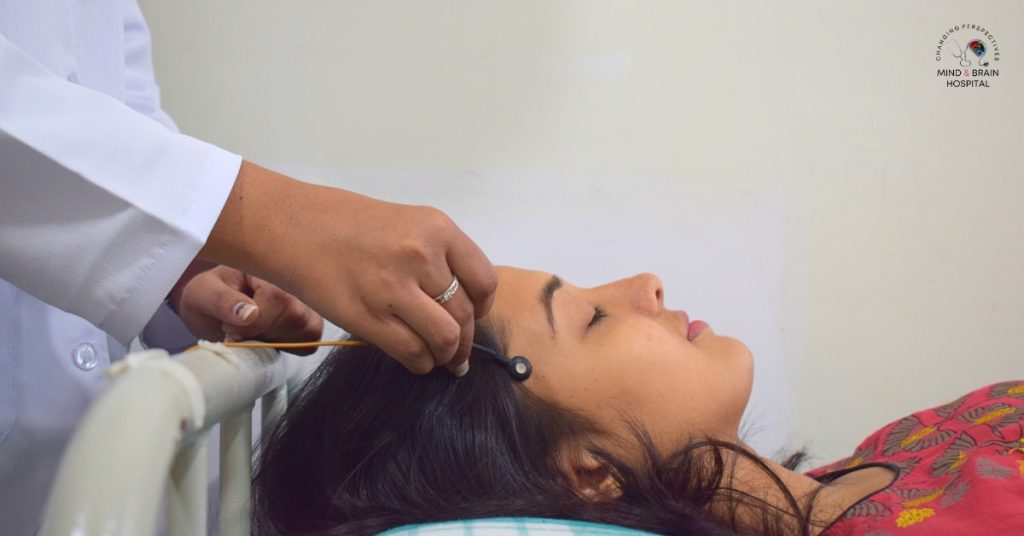Introduction
In the 1800s, scientists made groundbreaking discoveries about electrical activity in nerve cells and how they communicate through electrical currents. Michael Faraday’s research on changing magnetic fields generating electrical currents laid the foundation for a remarkable therapy known as Repetitive Transcranial Magnetic Stimulation (rTMS). Developed in 1985 by Anthony Barker, rTMS has revolutionized the field of neuroscience by providing a safe and non-invasive treatment for various psychiatric and neurological disorders. In this blog post, we delve into the fascinating world of rTMS, exploring its mechanism, applications, and benefits for patients.
What is rTMS and how is it different from TMS?
Transcranial Magnetic Stimulation (TMS) involves a series of short magnetic pulses directed to the brain to stimulate nerve cells. The magnetic pulses stimulate area neurons and change the functioning of the brain circuits involved. the effects of a single TMS pulse last only for a fraction of a second but researchers started to ask the question if we would repetitively use TMS pulses could we maybe activate neurons for a longer time in other words can we change the activity of the brain for a while even after the stimulation is over this repetitive use of TMS unsurprisingly is called repetitive TMS or rTMS.
Repetitive TMS (rTMS) is a variation of TMS where stimulation is provided in sessions of same condition to create long-term excitation in the brain cortex. In rTMS, the electric activities in the brain are influenced by the magnetic fields. The electromagnetic induction generated by rTMS is painless and safely passes through the skin and skull. Then, it produces small electric currents in the region of the brain just under the coil. In this procedure of treatment, multiple parameters are involved that can be changed to reach different treatment goals. These concurrent parameters include the number of stimulations, stimulation intensity, stimulation frequency, length of intervals between stimulations and the stimulated areas of the brain. Scientists have categorized uses of brain stimulation into three areas, namely pathophysiology, brain’s normal functions and treatment.

How does rTMS work?
rTMS can be applied in various ways, with two main paradigms: conventional and patterned rTMS. Conventional rTMS includes low-frequency and high-frequency stimulation. Low-frequency rTMS involves stimulation at approximately one pulse per second for 15 to 30 minutes. Conversely, high-frequency rTMS employs faster pulses (10-20 per second) for 2 to 4 seconds, interspersed with 20-second rest periods. High-frequency rTMS has been found to induce synaptic plasticity, strengthening brain connections and overall activating brain activity. On the other hand, low-frequency rTMS opposes plasticity, reducing brain activity.
However, the effects of rTMS can vary based on the individual’s baseline brain activity. Measurements of baseline brain activity can help optimize the selection of rTMS parameters. Additionally, patterned paradigms such as theta burst stimulation and quadripole stimulation offer alternative approaches, with theta burst stimulation being particularly promising due to its rapid bursts of three pulses repeated five times per second.
Who benefits from rTMS?
Repetitive Transcranial Magnetic Stimulation (rTMS) has emerged as a safe and non-invasive treatment option for various psychiatric and neurological disorders. Individuals diagnosed with depression, Obsessive-Compulsive Disorder (OCD), Post-Traumatic Stress Disorder (PTSD), Tourette’s Syndrome, and movement disorders can potentially benefit from rTMS therapy. By targeting specific brain areas and modulating neuronal activity, rTMS provides a new avenue for managing these conditions and improving the quality of life for patients.
Common side effects
While rTMS is generally safe and well-tolerated, it may cause some side effects, including scalp discomfort and pain, headaches, tingling, spasms or twitching of facial muscles, and lightheadedness. It’s essential to communicate any concerns or adverse effects experienced during the treatment to your healthcare provider for appropriate management and support.
Evaluation before rTMS treatment
Before undergoing Repetitive Transcranial Magnetic Stimulation (rTMS) therapy, it is crucial to undergo a comprehensive evaluation to ensure the treatment’s safety and suitability for each individual. This evaluation process involves various examinations and discussions with healthcare professionals to determine the appropriateness of rTMS as a therapeutic option. In this section, we will explore the essential evaluations conducted before initiating rTMS treatment and highlight crucial factors to discuss with your healthcare provider.
Physical and Mental Health Evaluations
To guarantee the safety of rTMS treatment, healthcare providers follow a thorough evaluation process, which includes:
Physical exams and laboratory tests: These assessments aim to identify any underlying medical conditions that may impact the effectiveness or safety of rTMS therapy.
Mental health evaluation: A comprehensive assessment of your depressive symptoms and overall mental health is conducted. This evaluation helps healthcare professionals understand your specific condition and develop a personalized rTMS treatment plan.
Tailoring the treatment plan: Based on the results of the physical and mental health evaluations, healthcare providers can customize the rTMS treatment to address your unique needs. This ensures that the therapy is both safe and effective in managing your depressive symptoms.
Key Factors to Discuss with Your Healthcare Provider
During the evaluation process, it is essential to communicate certain factors to your healthcare provider. These factors will help them make informed decisions about the suitability of rTMS for your individual case. Be sure to discuss the following:
Pregnancy: Inform your healthcare provider if you are currently pregnant or planning to become pregnant. This information is crucial for determining the safety of rTMS during pregnancy.
Metal or Implanted Medical Devices: If you have any metal objects or implanted medical devices in your body, such as pacemakers or cochlear implants, notify your healthcare provider. Certain metallic objects may interfere with the magnetic fields used in rTMS, potentially compromising the treatment’s effectiveness or safety.
Medications and Supplements: Provide a comprehensive list of all medications, including prescription drugs, over-the-counter medicines, herbal supplements, vitamins, and other supplements you are currently taking. This information is vital as some medications may interact with rTMS or influence its effects.
History of Seizures or Epilepsy: If you have a history of seizures or a family history of epilepsy, it is essential to inform your healthcare provider. Seizure disorders can impact the suitability of rTMS treatment and require careful consideration.
Other Mental Health Conditions: Discuss any additional mental health conditions you may have, such as substance use disorders, bipolar disorder, or psychosis. These conditions can influence the treatment plan and help healthcare providers determine the best approach for your specific needs.
Brain Damage or Injuries: If you have experienced brain damage from illnesses, injuries, or conditions like brain tumors, strokes, or traumatic brain injuries, inform your healthcare provider. These factors may affect the safety and effectiveness of rTMS treatment.
Headaches and Other Medical Conditions: Inform your healthcare provider if you experience frequent or severe headaches or have any other significant medical conditions. These factors can be relevant when tailoring the rTMS treatment plan.
Previous rTMS Treatment: If you have undergone rTMS treatment in the past, it is crucial to inform your healthcare provider. Previous experiences with rTMS can provide valuable insights into treatment response and guide adjustments to optimize the current therapy.
Conclusion
Repetitive Transcranial Magnetic Stimulation (rTMS) is a safe and effective treatment option for psychiatric and neurological disorders. The evaluation process, including physical exams, lab tests, and mental health assessments, ensures personalized and tailored rTMS treatment plans. By communicating essential information to healthcare providers, individuals can maximize the benefits of rTMS therapy and improve their mental well-being. rTMS offers a non-invasive solution that can significantly enhance the quality of life for those suffering from various conditions.




